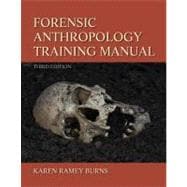
Note: Supplemental materials are not guaranteed with Rental or Used book purchases.
Purchase Benefits
What is included with this book?
Karen Ramey Burns is a practicing forensic anthropologist, teacher, writer, and human rights worker. She received her graduate education in forensic anthropology under the direction of the late Dr. William R. Maples at the University of Florida and developed experience in major crime laboratory procedures while working for the Georgia Bureau of Investigation, Division of Forensic Sciences. She continues to serve the state of Georgia as a consultant in forensic anthropology and as an appointed member of the Georgia Council on American Indian Concerns. She has testified as an expert witness in local,
state, and international cases.
Dr. Burns has devoted much of her professional career to international work, providing educational and technical assistance in the excavation and identification of human remains in Latin America, Haiti, the Middle East, and Africa. She documented war crimes in Iraq after the Gulf War (1991) and provided testimony in the Raboteau Trial in Gonaïve, Haiti (2000). She is the author of the “Protocol for Disinterment and Analysis of Skeletal Remains,” in the Manual for the Effective Prevention and Investigation of Extra-Legal, Arbitrary, and Summary Executions (1991), a United Nations publication.
In times of national emergency, she works for the National Disaster Medical System, part of the U.S. Department of Homeland Security. She was deployed for the Katrina/Rita Hurricanes disaster in 2005, Tri-State Crematory incident in 2002, the World Trade Center terrorist attack in 2001, the Tarboro, North Carolina, flood in 1999, and the Flint River flood of 1994.
Dr. Burns has contributed to several historic research projects, including a study of the Phoenician genocide in North Africa (Carthage), the identification of the revolutionary war hero Casimir Pulaski, and the search for Amelia Earhart. Dr. Burns is a coauthor of the award-winning book Amelia Earhart’s Shoes, Is the Mystery Solved? (2001), a discourse on the archaeological investigation.
Her research interests include microstructure of mineralized tissues, effects of burning and cremation, and decomposition. She teaches human osteology, forensic anthropology, and human origins at the University of Georgia, as well as forensic anthropology and expert witness testimony for the U.S. Department of Justice’s International Criminal Investigative Training
Assistance Program (ICITAP).
Dr. Burns is presently the Director of Field Investigations for EQUITAS,the Colombian Interdisciplinary Team for Forensic Work and Psychosocial Assistance, Bogotá, Colombia.
Found in this section:
1. Brief Table of Contents
2. Full Table of Contents
1. BRIEF TABLE OF CONTENTS
Chapter 1 Introduction
Chapter 2 Human Osteology
Chapter 3 Human Odontology
Chapter 4 Laboratory Analysis
Chapter 5 Field Methods
Chapter 6 Professional Results
Chapter 7 Human Rights Applications
Glossary
Bibliographies
Appendix A: Skeletal Biology, Forensic Anthropology and Criminalists
Appendix B: Human Rights Applications
2. FULL TABLE OF CONTENTS
Chapter 1: Introduction
The Basic Problem—The “Disappeared”
Physical Evidence
Death Investigation Specialists
Forensic Anthropology
Chapter 2: Human Osteology
Introduction
Skull
Shoulder
Chest
Backbone
Arm
Hand
Hip
Leg
Foot
Chapter 3: Human Odontology
Introduction
Tooth Recognition
Dental Aging
Dentistry Terms
Oral Disease.
Chapter 4: Laboratory Analysis
Introduction
Preparation
Skeletal Analysis
Review of Analysis
Basics of Human Identification
Chapter 5: Field Methods
Introduction
Preparation
Burial Location and Scene Investigation
The Excavation and Exhumation
Evidence Management
Quality Check
Questionnaire for Families of the Missing
Chapter 6: Professional Results
Record Keeping
Report Writing
Basic Ethics; Courtroom Testimony
Chapter 7: Human Rights Applications
The Role of the Scientist
Participants in International Mission
Planning Scientific Missions
Types of Missions
Results of Human Rights Missions
The Future.
Glossary
Bibliographies
Appendix A: Skeletal Biology, Forensic Anthropology and Criminalists
Appendix B: Human Rights Applications
The New copy of this book will include any supplemental materials advertised. Please check the title of the book to determine if it should include any access cards, study guides, lab manuals, CDs, etc.
The Used, Rental and eBook copies of this book are not guaranteed to include any supplemental materials. Typically, only the book itself is included. This is true even if the title states it includes any access cards, study guides, lab manuals, CDs, etc.